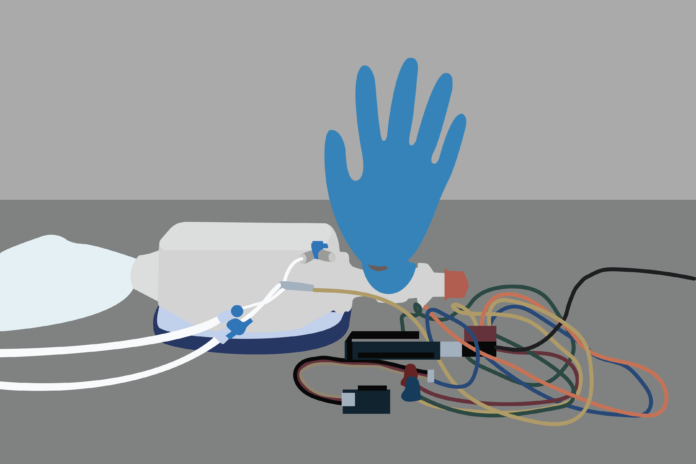Ventilator created with goal of 80% functionality for 10% of cost compared to commercially available device
In response to the national shortage of ventilators across the country, UC Davis biomedical engineers and clinicians have collaboratively developed an automated low-cost portable ventilator. The device has been named AmbuBox and is on track to becoming publicly available in the near future following urgent authorization from the FDA.
The AmbuBox is expected to cost between $100 and $500, according to engineers and developers involved in the ongoing project. This contrasts greatly with commercially available ventilators, which can cost upward of $50,000 in some cases.
The AmbuBox design was originally developed by clinicians and engineers at MiNI Lab, which is directed by Dr. Tingrui Pan, a professor within the Department of Biomedical Engineering. His lab is particularly interested in exploring interdisciplinary links between nanoengineering, biomedicine, and related fields.
“The idea was first Dr. Pan’s idea,” said Dr. Andrew Li from the Department of Surgery at UC Davis Medical Center. “Whether it’s pumps or converting small volumes of liquid from one area to another, that’s kind of [MiNI Lab’s] specialty — they’re very interested in the flow of liquids and gases, and this was the perfect application.”
After learning early on that there could be a potential shortage of ventilators due to the pandemic, Pan started leading work on easing this issue.
“During the pandemic, I was working with my collaborator in the Medical Center and they told us that there could be a potential shortfall on the ventilator, and so we started working on it,” Pan said. “The goal is not to create a new category of ventilator [but rather] to make a simpler ventilator design that can be quickly manufactured.”
There are many commercially available ventilators that are equipped with advanced technology in order to improve the user experience, according to Pan. These ventilators are furnished with advanced interfaces and various breath delivery settings, which significantly raise the price of the device but do not provide a significantly greater degree of care to the patient.
“[The traditional ventilator] consists of thousands of components that you have to order, not only from the US but [also] globally,” Pan said. “If there’s any glitch in the supply chain, you might not get a ventilator in a short time frame.”
With this challenge in mind, Pan’s lab emphasized a minimal amount of working parts when they were considering various designs for the AmbuBox. Some inspiration for the project came from AmbuBag, an existing manual ventilator which requires a nurse or doctor to squeeze air into the bag to allow for ventilation.
“[AmbuBox] is a very simple design with no major moving parts,” Li said. “This is in contrast with a traditional ventilator that often has many, many moving parts, and on top of that, sometimes very elaborate electronics. [AmbuBox] is more meant to be a low cost, reliable, durable, hopefully less power-consuming device with the same basic features that would help sustain someone’s respiratory system.”
The AmbuBox has been designed to include an automated compression mechanism for the airbag, making it so that a doctor or nurse is not needed to operate this ventilator. The device is designed to utilize existing compressed air from a medical center, for example.
“Our prototype will be very inexpensive, it will [use] less power,” Li said. “The machine really will drive a breath into a patient with the use of compressed air. Compressed air is relatively easy to obtain versus battery power. The only thing that’s really battery controlled are the pressure sensors and also the solenoid valve that controls the flow of compressed air into the chamber.”
In addition to the changes in power utilization made possible by AmbuBox’s design, developers of the prototype also hope to utilize existing mobile compressed air for the ventilator system.
“What we also would like to consider is medical transport, whether it’s via ambulance or medical airplane or air transport,” Li said. “All of those vehicles and aircraft have compressed air on board.”
Before the design can be finalized and sent to the FDA for approval, extensive testing must be conducted on the AmbuBox. This is already in progress and involves the use of various test lungs, which are devices designed to mimic the human lung.
“[The test lung is] essentially a balloon that’s supposed to mimic the elasticity and compliance of lung tissue,” Li said. “The [human] lungs are made up of [somewhere in the order of] hundreds of millions of little balloons called alveoli. But unlike a standard balloon, the lungs have a very low surface tension, so it’s very easy to inflate them.”
Due to the delicate nature of alveoli, Li agrees that it is very easy to over inflate the lung tissue in a select number of COVID patients. This over inflation, called barotrauma, is thus a danger that engineers must factor into the design of AmbuBox. Despite the challenges of developing this ventilator, engineers and clinicians are hopeful the device will prove successful once testing has been concluded.
“Preliminary data looks very good,” Li said. “We’ll be planning definitive testing on a much larger test lung piece of equipment in the respiratory therapy area of the Medical Center.”
Written by: Dina Gallacher — science@theaggie.org





